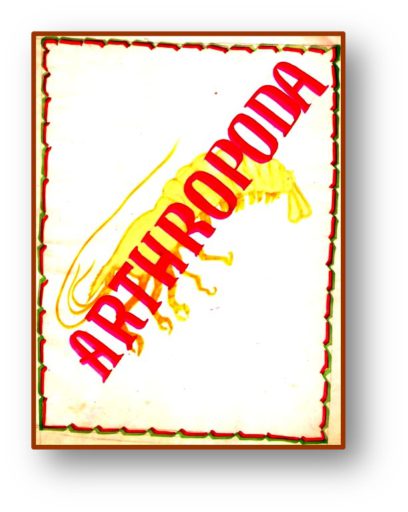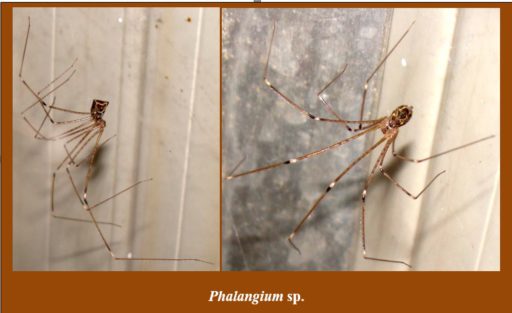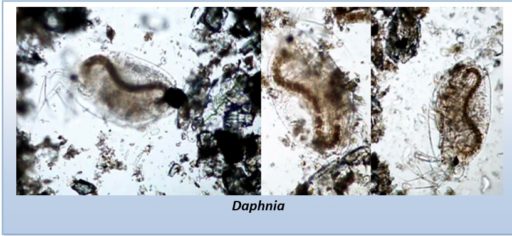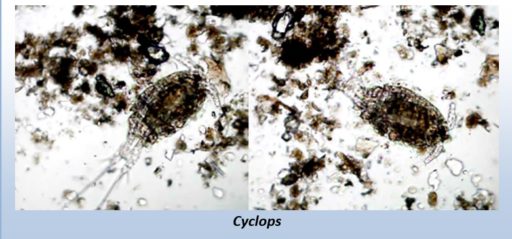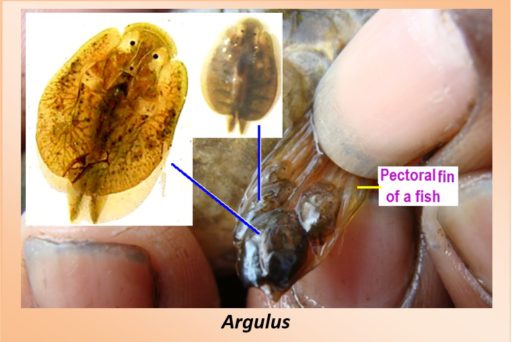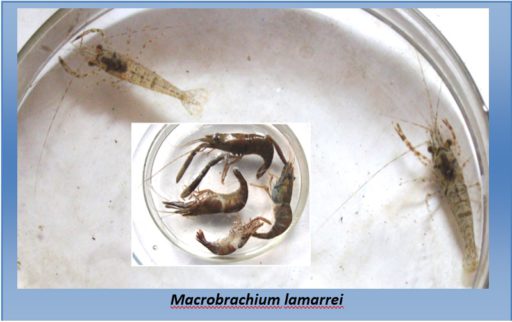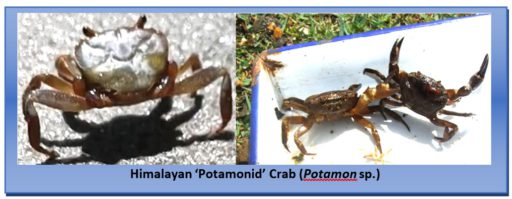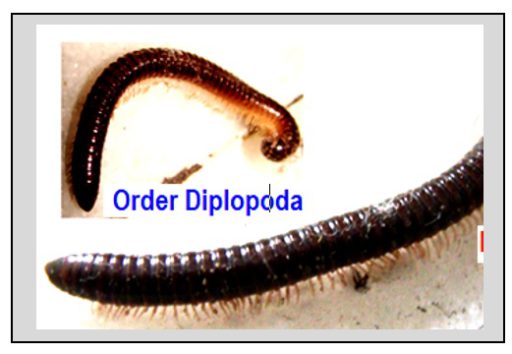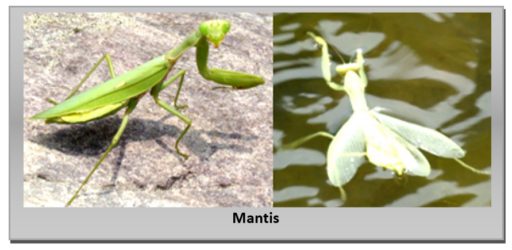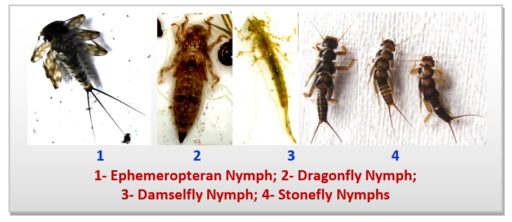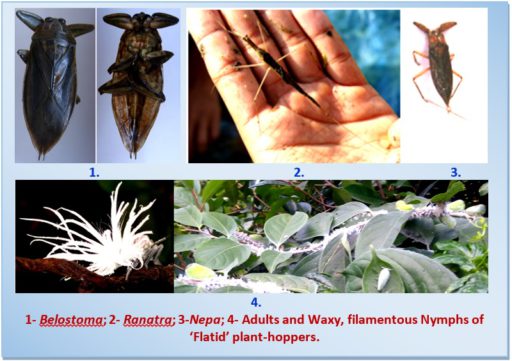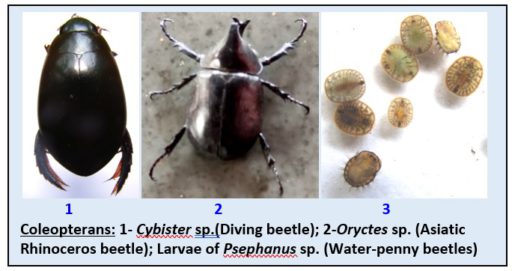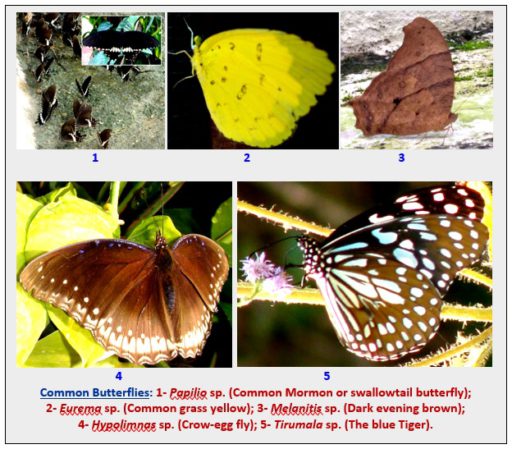[NOTE:Some assorted photographic illustrations, supported here, are from the
field/backyard, at Dehradun, Uttarakhand, India]
Making Biology students interested in Etymologies’ !!!
v FUN TO LEARN BIOLOGICAL TERMINOLOGY
v THE LANGUAGE OF BIOLOGISTS
v SOWING SEEDS OF SYSTEMATICS/TAXONOMY AT THE GRASSROOT LEVEL
LEARNING BIO- ETYMOLOGY
Over a period in past centuries, Science is general and Biology in particular has accumulated a vast array of words to communicate fact(s) or phenomena through deriving their meanings.
The episode(s) of ‘Bio-etymology’ are, thus, devoted to analyzing the hidden meanings derived from the Names of various Animal Phyla and Classes, along with the terms specifically used to describe their respective diagnostics, important examples (Genus or species) etc.
Ø Recollecting the Introduction
of PART – 1:
At any level, may it be animals in general or Man in particular, there is some structured or indicative or behavioural system of communication. It is simply referred to as a kind of ‘Language’. In a broader sense, ‘Language’ is the method of communication that involves the use of various languages (in various countries) spoken by man. Articulation of words in a definite sequence is the basic of formulating a Language and knowledge of words forming it and their ‘sense’ is of utmost importance. Accumulation of a treasure of words constitutes what is called ‘Vocabulary’ defined variously as follows:
1. The words of a language.
2. The body of words used in a particular language.
3. All the words that exist in a particular language or subject.
4. A list or collection of the words or phrases of a language, technical field etc.
5. A listing either selective or exhaustive, containing the words and phrases of a language, with meaning or translations into another language.
The Previous Episodes of Bio-etymology :
CLICK HERE |
PHYLUM – ARTHROPODA
[Gk. arthron = joint + pous pod- =foot]
The name of the Phylum literally means ‘joint-footed’ animals, including a vast array of animals commonly known as – scorpions, spiders, ticks, mites, shrimps, crabs, crayfish, water flea, millipedes, centipedes, housefly, honey bees, vasps, butterflies, moths, termites, ants, beetles, bugs, cockroaches, grass-hoppers etc. The branch of study of Arthropods is called ‘Arthropodology’.
With these diverse common names of animals included in the Phylum, ‘Arthropoda’ constitutes the ‘largest Phylum’, representing about 85% of species (over 1.0 million described species), venturing not only into every ecological entity but also subsisting on all kinds of plants and animals (as parasites/commensals/symbionts etc.). Interestingly, they include the first ‘flying’ animals, too. [Flying animals will be encountered again, when we reach Phylum Chordata and study the Reptiles and ‘the masters of air’, the Birds].
HISTORY
Aristotle (384 – 332 BCE) mentioned about some crabs and other arthropods but the ‘father of modern Taxonomy’ and Swedish Botanist/Zoologist/Physician Carl Linnaeus or Carl von Linne or Carolus Linnaeus [Latinized name after becoming famous for formulating ‘binomial nomenclature’; also becoming famous as Carolus a Linne after 1761] included all such animals in the group named as ‘Insecta’. French Naturalist Jean Baptiste de Lamarck (1744 – 1829) divided this group into Crustacea, Hexapoda and Arachnida. German physician and Botanist Karl Theodor Ernst Von Seibold (1766 – 1866) coined the term ‘ARTHROPODA’ for the Phylum.
[NOTE: Please also refer to: The correct authorship of the taxon name ‘Arthropoda’; https://www.researchgate.net/publication/258439568_The_correct_authorship_of_the_taxon_name_’Arthropoda‘]
DEFINITION / DIAGNOSTICS
It is in the publication entitled ‘Erster Theil’, which dealt with invertebrates, the term ‘ARTHROPODA’ was first used by von Seibold (1848) and the original definition included was as under:
‘Animals having a perfectly symmetrical form, and articulated organs of locomotion. The central masses of the nervous system consist of a ring of ganglia surrounding the oesophagus, from which proceeds a chain of abdominal ganglia’.
· Free living (marine, brackish, freshwater, terrestrial or aerial) or parasitic (on Plants and Animals).
· Triploblastic: [Gk. triploos / triples; Latin triplus = threefold / three + blast (os) = denoting embryonic cell / germ layer of an embryo / germ / sprout + -ic < Latin –icus / Gk. –ikos = the suffix used to form adjectives], i.e., the animal body developing from three primary germ layers viz., Ectoderm, Endoderm and Mesoderm.
· Bilaterally symmetrical: [Gk. bi = two + lateros = sides], i.e., body divisible into two identical halves (right and left) only in one plane passing through the median longitudinal
axis.
· Body metamerically segmented: [Gk. meta = after + meros = a part, a fraction]; [Segment + ation < Latin segmentum / Gk. tmema or tmemata = a strip or piece cut off; a division, section + ation = a suffix used in nouns, denoting ‘action’].
PSEUDOMETAMERISM vs TRUE METAMERISM
Please refer to Bio-etymology PART – 5
HOMONOMOUS vs HETERONOMOUS METAMERISM
Please refer to Bio-etymology PART – 5
· Body: divisible into head, thorax and abdomen. Often, head and thorax fused to form cephalothorax.
· Exoskeleton: Made of thick and hard ‘CHITIN’ (a Nitrogenous Polysachharide)[French chitine / Gk. khiton = covering], secreted by epidermis.
· Appendages: ‘jointed foot or appendages’ are borne by each segment; adapted to various roles like food gathering or ingestion, locomotion, respiration, copulation etc.
· Eucoelomate: [Gk. eu = true, well, good + koiloma / koilia = hollow, cavity]
In all the higher bilateria, from Annelids onwards, the blastocoel gets obliterated by the development of endodermal ‘archenteron’ [embryonic gut] and another space (true coelom or eucoelom) is created between two layers of mesodermal cells (peritoneum) present between the gut (endoderm) and the body wall (ectoderm).
Examples: Annelida to Chordata. ……………… Bio-etymology PART – 9 onwards.
Arthropods have coelom reduced to small cavities in excretory and reproductive organs;
replaced elsewhere by blood sinuses with coalesce together to form a large perivisceral (around viscera) cavity – the haemocoel.
For the types of Coelom in ‘Bilateria’,
Please refer to Bio-etymology PART – 5
· Digestive system: complete. Mouth ‘appendages’ are referred ‘mouth parts’, adapted for various modes of feeding ranging from sucking to piercing or cutting.
· Blood vascular system: open type due to the presence of fused ‘sinuses’ filled with haemolymph, may be containing haemocyanin pigment. Pulsatile ‘Heart’ is long and tubular, mid-dorsal; communicating with the haemocoel.
· Respiration: through general body surface, gills, tracheae or book-lungs.
· Nervous system: typical Annelidan type, with a circumenteric ring and 2 ventral nerve cords. [Lain circum = round, around + Gk. enteron = gut / alimentary canal] i.e., the part of central nervous system made of highly ganglionated ‘nerve ring’ encircling the pharynx and a double ventral nerve cord.
· Sensory organs: include eyes (simple or compound), chemo- and tactile receptors, statocysts, auditory organs etc.
· Dioecious: [Gk. di = two + oiki (on) or oikos = house]; male and female reproductive organs (Gonads) at two separate places i.e., male and female individuals are separate. Oviparous or ovoviviparous.
· Fertilization: internal.
· Development: direct or indirect. When indirect, it is with one to many larval stages.
· Parthenogenesis: found in some cases.
CLASSIFICATION
Being a heterogeneous assemblage, divergent views have been expressed and thus various systems have been adopted from time to time to classify the Phylum. Not going into the intricacies of various systems of classification (available currently), a traditional 3 Subphyla system is presented here with a view to deal with the ‘etymology’ of various ‘taxa’.
SUBPHYLUM I: TRILOBITOMORPHA
[L. tres/Gk. treis = three + lobos = lobe + morphe = form]
Extinct (Cambrian to Permian), marine, bottom-dwelling, ‘3-lobed’ forms.
Example(s):
· Triarthrus: [L. tres/Gk. treis = three + Gk. arthron = joint] i.e., small Ordovician trilobite with ‘3 joints’ (= 3 lobes).
[Ref: https://en.wikipedia.org/wiki/Triarthrus]
SUBPHYLUM II: CHELICERATA
[Gk. khele/chele = claw + keras = horn + ata = group]
A group of Arhtropods bearing 1 pair preoral appendages called ‘chelicerae’ (a horn-like appendage with claws), as found in the examples like scorpions and spiders. IInd pair postoral appendage is called ‘Pedipalp’ [L. pes, ped + foot + palpus / palpare = a feeler; to stroke or touch freely or feel], followed by 4 pairs of walking legs.
[Gk. meros = thigh + stoma = mouth + ata = group]
i.e., referring to a ‘group’ of Arthropods possessing appendages called ‘mouthparts’ at their proximal end but swimming legs at their distal end. More appropriately, ‘the mouth’ is situated on underside of the centre of prosoma, between the bases (‘thigh’) of the walking legs.
Subclass 1: Xiphisaura
[Gk. xiphos = sword + oura = tail]
i.e., referring to an arthropod having a long, slender, sword-like stiff tail.
Example(s):
· Limulus (Horse-shoe crab or King crab): [L. limulus/limus = a little askew or odd/showing askance/slightly oblique; moving eyes to the side and not looking directly] i.e, referring to the character of ‘vision’ with a pair of median eyes and a pair of ‘lateral compound eyes’ with sideways glance (‘squint-eyed’, as if squinting).
The common name ‘horse shoe crab’ originates from the shape of the head, looking just like the shoe on a horse’s foot. They are the oldest living representatives (around more than 300 million years old) of their kin, hence called ‘living fossil’.
[Ref: https://www.biolib.cz/en/image/id170262/]
Subclass 2: Eurypterida
[Gk. eurus = broad or wide + pteron = wing]
i.e., extinct (about 467 million years ago) marine arthropods with a pair of ‘wide’ swimming appendages (spread-out wing like).
Example(s):
· Eurypterus (Sea Scorpion): Meaning, as that of the Subclass.
CLASS 2: ARACHNIDA
[Gk. arachne = spider + eidos = form]
i.e., referring to such Arthropods, named after the myth of the hubristic human weaver ‘Arachne’, who was turned into a ‘spider’ [Old English spiora/Danish spinder = spinner] i.e., an animal which has the quality of ‘spinning the web’.
Order 1: Scorpionida (= Scorpiones) (True Scorpions): [Gk. skorpios = to cut or shear + eidos = form] i.e., the eight-legged Arthropods with prominent, pincer-like ‘Pedipalps’ used for catching/holding and ‘cutting or shearing’ the prey.
Example(s):
· Buthus: [Gk. bous = an ox/beef (as grazing)] i.e., referring to a ‘cow stinger’ or ‘swift’, because of its powerful ‘sting’.
[Ref.: https://askabiologist.asu.edu/scorpion-anatomy]
Order 2: Pseudoscorpionida (= Chelonethida) (Tiny false scorpions or Book Scorpions): [Gk. pseudo = false + skorpios = to cut or shear + eidos = form] i.e., small sized arachnids, sometimes found in old books, resembling tailless scorpions having pincer-like pedipalps. .
Example(s):
· Chelifer : [Gk. khele = claw + fero = bear, carry] i.e., tiny Pseudoscorpions bearing prominent claw like pedipalps.
[Ref.: https://extension.psu.edu/pseudoscorpions]
Order 3: Araneae (True Spiders): [L. aranea = spider] i.e., referring to the Arthropods, well known as ‘spiders’ [Old English spiora/Danish spinder = spinner] i.e., the 8-legged Arthropod, which has the quality of ‘spinning the web’.
Example(s):
· Lycosa (Wolf Spider, ground spider or hunting spider): [L. lycos/Gk. lykos = wolf] i.e., relatively large-sized spiders; named ‘wolf spiders’ due to wolf-like habit of chasing and pouncing upon the prey.
· Achaearanea (House Spider/Comb-footed spiders): [L. achaea /Gk. akhaia = one of the regional units of Greece + L. aranea = spider] i.e., the spiders commonly found in houses (= an inhabitant of ‘Achaea’).
[Ref.: https://en.wikipedia.org/wiki/Lycosa]
Order 4: Solifugida (False spiders, Sun spiders, Camel spiders or wind spiders or scorpions): [L. solifugae/solifuga = those that flee from the sun] [ English, soli is a verb and a third person singular imperative form of ‘solar’ i.e., ‘sun’ + L. fuga/Gk. phuge = running away or an act of fleeing] i.e., referring to such spiders having the habit of only appearing at night. Often they are seen in the tents of ‘travelers’, racing over their beds after the dusk. All inhabiting warm and arid habitats, including all warm deserts and scrublands in all continents except Antarctica and Australia.
Example(s):
· Galeodes: [L. galeo = to cover with a helmet] i.e., referring to a kind of spiders having ‘helmet-like’ plate at the front end of the body indicating towards the ‘prosoma’ part of body having a large, relatively well-defined anterior carapace, bearing eyes and chelicerae.
[Ref.: https://www.faunafondness.com/galeodes-arthropoda/]
Order 5: Palpigradi (Micro-whip scorpions): [L. palpus = to feel + gradi = walk] i.e., referring to small-sized scorpion-like creatures, using their ‘pedipalps’ for walking (locomotion) so that they appear to be walking on 5 legs (i.e., pedipalps + 4 legs). Their common name ‘micro-whip scorpions’ originates from the segmented abdomen terminating into a ‘whip-like’ 6-jointed flagellum.
Example(s):
· Koenenia: [Gk. koinonia = communion, joint participation] i.e., referring to the ‘joint participation’ of ‘pedipalps and legs’ during locomotion.
[Ref.: https://en.wikisource.org/wiki/Page:EB1911_-_Volume_02.djvu/322]
Order 6: Pedipalpi (= Uropygi) (Elongate whip scorpions or Vinegaroons): [L. pes / ped = foot + palpus = to feel] i.e., referring to the fact that out of 4 pairs of legs (=foot) the first pair is quite long and ‘antenniform’ used as feelers (= palps) to feel about the prey in darkness. Or
Uropygi: [Gk. oura = tail + puge = rump] i.e., referring to the whip-like tail/flagellum (hence, the common name) on the end of pygidium, a small plate made of the last 3 segments of the abdominal exoskeleton.
The another common name ‘vinegaroon’ refers to the ability of throwing a spray of concentrated (85%) acetic acid from the base of the whip-like tail.
Example(s):
· Mastigoproctus: [Gk. mastix = whip or flagellum + proktos = anus, rectum] i.e., referring to the example possessing ‘whip-like’ extension at the anal segment.
[Ref.:https://en.wikipedia.org/wiki/Mastigoproctus_giganteus]
Order 7: Amblypygi (= Phrynichida) (Flattened scorpion spiders): [Gk. amblys = blunt or dull + puge = rump] or [Gk. phrynos = toad + eidos = form] i.e, referring to the flattened spiders having ‘a blunt rump’ (as opposed to Scorpions which have a sharp rump or tail). Similar in appearance to ‘Uropygi’, but without a telson or tail or ‘Phrynichida’ may be referring to the ‘toad-like’, roughened body surface.
Example(s):
· Charinus: [L. charinus = a male given name] [Gk. chari– = sexual joy/grace/favour/reward/remuneration] [Gk. charinus = a stock name for the ‘adulescens’ (= youth) in the ‘palliata’ (= a type of comedy at Rome by Plautus).]
In the ‘epigrams’ (= satire) ‘Charinus’ is a sexual pervert, a showy parvenu (= a person who gained wealth, influence or celebrity), or both i.e., luxurious ostentation and pretentiousness are equated with sexual deprivation.
Most probably the name of the Genus ‘Charinus’ in particular and the order in general, is characterized by the fact that all exhibit ‘polygyny’, courtship lasting from one to eight hours and a pair mating multiple of times, sometimes over several weeks (as if ‘a sexual pervert’ or that suffered ‘sexual deprivation’).
` [Ref.: https://www.britannica.com/animal/tailless-whip-scorpion]
Order 8: Ricinulei (= Podogna) (Hooded tick Spiders):[L. ricinus = caster oil plant/a kind of tick] i.e., referreing to a kind of spiders with a body form looking like ‘ticks’ and also because of the fact that ‘castor seeds’ have markings and a bump
= caruncle) at one end that resemble certain ‘ticks’ (hence, tick spider). The common name ‘hooded tick spider’ is because of the fact that there is a hinged plate, ‘the cuculus’ on the prosoma, acting as a ‘hood’ that covers the mouth parts.
The another name of the Order ‘Podogona’ [Gk. podos = foot + gona = seed, generation] refers to the IIIrd pair of ‘legs’ modified into copulatory organs, specialized for sperm transfer.
Example(s):
· Ricinoides: [[L. ricinus = caster oil plant / a kind of tick + eidos = form] referring to the body form like a tick or a caster seed.
[Ref.: https://www.americanarachnology.org/about-arachnids/arachnid-orders/ricinulei/]
Order 9: Opioliones (= Phalangida) (Harvestmen/Harvest spiders/Daddy longlegs): [L. opiliones = shepherds] i.e., referring to the similarity between the unusually ‘long legs’ (hence, daddy long legs) of the spiders and the European shepherds who used to use ‘stilts’ to better observe the wandering flocks of sheep from a distance. The name ‘Harvestmen’ originates from their being common in the late summer at harvest time. When spotting a harvestman, its body is surrounded by 8 long legs (2.5 – 5.0 cm). Native Americans call them ‘Grandfather gray-beard’, meaning ‘Feet of Hairs’.
Example(s):
· Phalangium: [Gk. phalanx = finger or toe bone] i.e., referring to the spiders called ‘Joint-Spiders’ on account of the sharp joints (7- jointed) on their long legs (like the joints in our fingers / toes).
[Ref.: https://depositphotos.com/stock-photos/opiliones.html]
Order 10: Acarina (Ticks and Mites): [L. acarus/Gk. akari = mite], [Old English mite = tiny insect; Proto-Germanic mito = biting insect, cutter], [Old English ticia = parasitic animal] i.e., reffering to small-sized free-living or parasitic arachnids having habit of ‘cutting’ the food/host or causing diseases by parasitizing a host (plats/animals).
Example(s):
· Sarcoptes (Itch Mite): [Gk. sarks = flesh + kopto = to cut] i.e., referring to a parasitic itch mite (of man) causing ‘scabies’ [L. scabere = to scratch; < Middle English denoting ‘skin diseases’] or ‘mange’ [L. manducare = to eat; ‘mange’ is a middle English name of manjewe/manjeue derived from ‘mangier’ = to eat; French manger = to eat]
· Ixodes (Sheep Tick or the Hard Ticks): [Gk. ixodes = like bird-lime, sticky, clammy] i.e., referring to the ectoparasites of vertebrates, firmly ‘sticking’ to the body of host(s).
[Ref.: https://simple.wikipedia.org/wiki/Acarina]
SUBPHYLUM III: MANDIBULATA
[L. mandere/mandibula = to chew/jawbone i.e., the one used for chewing + ata = a group]
i.e., the Subphylum characterized by the 1 pair of ‘jaws’ (mandibles) along with other mouth parts viz., 1 or 2 pairs of maxilla.
CLASS 1: CRUSTACEA
[L. crusta = rind, shell, crust; a hardened layer deposited over something soft]
i.e., referring to the anterior part of the body (head + thorax = cephalothorax) mostly covered by a hard covering called, ‘carapace’ (French, carapace = tortoise shell).
Subclass 1: Cephalocarida (Horseshoe shrimps): [Gk. kephale = head + karis = *shrimp] i.e., referring to the most primitive crustaceans with a *shrimp-like (carapace) head which is ‘horseshoe-shaped’. (* Shrimp = Middle English, shrimpe/ Middle Low German schrempen = to contract or wrinkle i.e., referring to some small-sized, weaker, dorsoventrally depressed, wider than deep crustaceans with a short rostrum).
Example(s):
· Hutchinsionella: [named after American Ecologist, G. Evelyn Hutchinson by his graduate student, Howard Sanders, who first discovered it].
[Ref.: https://en.wikipedia.org/wiki/Cephalocarida]
Subclass 2: Branchiopoda: [Gk. branchia = gills + podos = foot] i.e., referring to those crustaceans which have a number of ‘gills’ present on many of the animal’s appendages, including mouthparts.
Order 1: Anostraca: [Gk. an-/a- = not, without + ostrakon = hard shell] i.e., referring to small crustaceans lacking a ‘carapace’.
Example(s):
· Artemia (Fairy shrimp, Brine shrimp) : [L. artemia/Gk. artemis = Greek goddess Artemis; safe, unharmed, pure, the stainless maiden. Goddess of hunting and nature, loving to hunt and spending much of her time in the forest] i.e., referring to the feeding habits of ‘Artemia’, voraciously consuming phytoplankton.
[Ref.:https://en.wikipedia.org/wiki/Branchiopoda]
Order 2: Notostraca: [Gk. noton = back or dorsal part of body + ostrakon = hard shell] i.e., referring to a broad, shield-like, dorsoventrally flattened, smooth ‘carapace’ without a rostrum and including the head and two sessile compound eyes, located on top of the head.
Example(s):
· Apus or Lepidurus apus (Tadpole shrimp): [Gk. lepis = scale + L. uro– = tail] [ Gk. apous = without feet] i.e., referring to an example, characterized by the presence of a ‘scale-like’ caudal lamina (supra-anal plate) on the telson and extending backwards between and slightly above the long caudal furca; and 41 – 46 pairs of ‘phyllopods’ (Gk phyll = leaf + podos = foot), the swimming appendages under the body . The common name ‘Tadpole shrimp’ derives from the animal’s distinctive body shape (ova shell-like carapace) and a slender, flexible abdomen.
[Ref.: https://en.wikipedia.org/wiki/Notostraca]
Order 3: Diplostraca or Cladocera (Water Flea): [Gk diplous = double + ostrakon = hard shell] [Gk klados = branch + keras = horn] i.e., referring to a transparent ‘bivalved carapace’ (=Diplostraca), completely enclosing the body and a strongly biramus (branched/bifurcated) second antennae (hence, Cladocera), the sole means of a rather flea-like jerky movement (hence, ‘water flea’).
Example(s):
Daphnia: [< L. daphne < Gk. daphne = laurel] i.e., referring to a female ‘nymph’ of Greek myth, who, fleeing Apollo, was saved by being changed into a ‘laurel’ tree (her arms changed into ‘branches’, akin to ‘branched’ antenna of Daphnia). [Ref.: https://en.wikipedia.org/wiki/Diplostraca]
Subclass 3: Ostracoda: [Gk. ostrakodes = covered with shell or ostracon = shell] i.e., referring to laterally flattened bodies protected by a bivalve shell (superficially resembling the shell of a clam) with a hinge on the upper (dorsal) region (unlike Diplostraca, without a hinge). .
Example(s):
· Cypridina, Cypris etc.: [L. cyprid-, cypris = a name for Venus, Roman goddess of love and beauty] i.e., referring to the ‘beauty’ of these microscopic crustaceans, unique for ejecting a blue luminous secretion (= luminescent beauty, comparable with the planet ‘Venus’, the brightest natural object) in water, when disturbed.
The light emitting component, synthesized in their body, is called ‘Cypridina Luciferin’ or ‘Vargula Luciferin’ from the species named Cypridina (= Vargula) hilgendorfii; responsible for bioluminescence in many deep-sea fishes which utilize Cypridina sp. as food.
[Ref.: https://en.wikipedia.org/wiki/Ostracod]
Subclass 4: Mystacocarida (Mustache Shrimp): [Gk. mystaco– = the moustache or the hair upon the upper lip + karis = grace, kindness and life + eidos = form] i.e., referring to the microscopic, marine, life forms living amongst coastal sand grains and characterized by much longer and most ‘setose’ (hairy) cephalic appendages (= like ‘moustache’, hence ‘Musstache Shrimp’) used for filtering detritus.
Example(s):
· Derocheilocaris: [ Gk. dero = long + chele = claw + karis = grace, kindness and life] i.e., referring to a ‘mystocarid’ crustacean having long ‘claws’, meaning thereby the long cephalothoracic feeding apparatus (Ist pair of thoracic limbs modified as maxillipeds along with maxillulae and maxillae).
[Ref.: https://en.wikipedia.org/wiki/Mystacocarida]
Subclass 5: Copepoda (Oar-feet): [Gk. kope = oar, handle + pous/pod = foot] i.e., referring to microscopic (0.2 to 5.0mm) freshwater and marine crustaceans so named as ‘oar-feet’ after the pair of swimming legs that move together like ‘oars’ on a sculling ship.
Example(s):
· Cyclops: [Gk. kuklos + circle + ops = eye] [Gk mythology Cyclopes = a giant, with one circular eye in the middle of the forehead] i.e., a small crustacean with one black or red eye in the middle of the head, named after the one-eyd monster of Greek legend.
[Ref.: https://en.wikipedia.org/wiki/Copepod]
Subclass 6: Branchiura (Gill-tails): [Gk. branchia = gills + L. uro– = tail] i.e., parasitic crustaceans, first named ‘Branchiura’ (or gill-tails) by Thorell (1864), based on the importance of the ‘tail’ morphology (but regarded as a misinterpretation of the character and probably the name ‘Branchiura’ is still in use based on the law of priority).
Example(s):
· Argulus (Fish Louse): [L. argulus = small spot or Gk. argos = many-eyed giant in Greek mythology] i.e., referring to the compound eyes in this parasitic species of fish or with dark spots of different sizes (as depicted on the ‘many-eyes giant’) on the dorsal and ventral abdominal surface and a peripheral black stripe on the carapace framing a yellowish area.
Subclass 7: Cirripedia: [L. cirrus = tendril, filament; Gk. cirri = curls of hair + Gk. pous/pod/pedes = foot/feet; L. Cirripedia = curl-footed] i.e., the sessile crustaceans with 8 pairs of thoracic feathery, quite long, cirri-like/filamentous appendages (called, ‘cirre’), being used to filter and divert the food towards mouth.
Order 1: Thoracica (Barnacles): [Gk. thorakikos / L. thorax = chest of body, the breast, chest; breastplate] i.e., referring to marine, sessile crustaceans; found attached to submerged objects (tidal rocks or bottom of ships); with a body made of 6 thoracic plates (segments) and 6 pairs of ‘cirre’.
The common name ‘barnacles’ originates from L. bernak or bernekke, meaning ‘species of northern European wild goose; or as a type of ‘shellfish’ found in clusters on submerged wood. Also, the word ‘barnacle’ has other meanings, referring to their habit or body form, e.g., Madieval Latin barneca = limpet (a marine mollusc which has a shallow conical shell); Proto-Celtic barinakos < barina = rock, rocky ground; Irish barenn = boulder.
Example(s):
· Lepas (Goose Neck Barnacle): [Gk. lepas = rock or limpet] i.e., referring to their resemblance with ‘limpets’ in appearance, found hanging in clusters by the long peduncle to the bottoms of ships, to floating timber or to submerged wood.
The name ‘Goose neck barnacle’ originates from the ‘stalk or long peduncle’ resembling the neck of a ‘goose’; and ‘goose barnacle’ is named because of the fact that:
The ‘wild goose’ (Anser bernicla or Bernicla leucopsis), also called barnacle-goose or bernacle-goose, inhabits northern parts of Europe and occasionally appears as a straggler in North America. It is found closely related to the common wild goose of North America (B. canadensis) and the brent- or brant-goose (Bernicla brenta). It has dark-brown or blackish upper parts and a black neck and head, with large white patches. This bird, known in the British islands only as a visitor, became the subject of a curious popular fictional story with the belief that it used to be bred from a tree growing on the sea-shore, either from the fruit of the tree or as itself the fruit (hence, called tree-goose) or from a ‘shell-fish’ which grew on this tree or from rotting wood in the water.
· Balanus (Rock Barnacle or Acorn-shell): [L. balanus / Gk. balanos = acorn] i.e., referring to a cirripid Crustacean attached to rocks or underside the ships and resembling the ‘acorn’ fruit of the oak, oval in shape and growing in a woody cup.
[Ref.: https://www.britannica.com/animal/cirripede]
Order 2: Acrothoracica (Burrowing Barnacles): [Gk. akro– = at the end, at the top, extreme, highest + thorakikos / L. thorax = chest of body, the breast, chest; breastplate] i.e., referring to a group of small, burrowing, dioecious (with prominent females and dwarf males), epibiotic barnacles found largely in carbonate sediments and skeletons of marine invertebrates like mollucs, corals, thoracican barnacles and bryozoans. They are without a hard carapace but have a sac-like soft body fixed to the surface by a chitinous disc on the anterior end of head. The cirri on the terminal body segments thought to be abdominal appendages are in fact from the thorax (i.e., thorax placed at the end or at the extremity, hence the name of the Order)
Example(s):
· Alcippe (Trypetesa): [Gk. alkippe < alke = strength + hippos = horse] i.e., ‘the one who has strong horses, the one who draws strength by the horses’; probably indicating towards their strength of excavating burrows inside gastropod shells inhabited by hermit crabs (hence, they are symbionts).
[Ref.: https://www.invertebase.org/portal/taxa/index.php?tid=57839]
Order 3: Ascothoracica: [Gk. askos = bag, a sac + thorakikos/L. thorax = chest of body, the breast, chest; breastplate] i.e., referring to the ecto-, meso-, and endoparasitic cirripede crustaceans of cnidarians (Scleractinia: Zoantharia, Antipatharia, and Alcyonacea) and echinoderms (Asteroidea, Crinoidea, Echinoidea, and Ophiuroidea). They are characterized by 6-segmented ‘thorax’ which is sac-like and has 1 pair of biramus appendages on each segment. Alternatively, mantle bilobed or sac-like but plates are absent.
Example(s):
· Dendrogaster: [Gk. dendron = tree + gaster = paunch, belly, stomach] i.e., referring to the endoparasitic female, exclusively occurring in the coelomic cavity of sea-stars; the carapace being modified into ‘derntritic mantle’, resembling the gonads or ‘pyloric or intestinal caeca’ of the host.
[Ref.: https://www.wikidata.org/wiki/Q6556607]
Order 4: Apoda: : [Gk. a- = not, without + podos = foot] i.e., referring to the parasitic crustaceans living in the mantle cavity of barnacles without a mantle and thoracic and abdominal appendages.
Example(s):
· Proteolepas:[Gk. protos > proteus = primordial, firstborn + lepas = rock or limpet] i.e., referring to a primitive type of barnacle parasite with reduced mantle and appendages.
[Ref.: https://www.wordnik.com/words/proteolepas]
Order 5: Rhizocephala: [Gk.rhiza = root + kephale = head] i.e., referring to highly degenerated, sac-like parasites attached ventrally to the abdomen of ‘crab’ hosts and sending root-like processes from its anterior end (head) to all body parts of the host for absorbing nutrients.
Example(s):
· Sacculina: [L. sacculus/saccus = a little sack or bag] i.e., referring to the body shape of the parasite.
[Ref.: https://en.wikipedia.org/wiki/Rhizocephala#]
Subclass 8: Malacostraca: [Gk. malakos = soft + ostrakon = shell] i.e., referring to a highly diverse group of crustaceans (e.g., crabs, lobsters, crayfish, shrimp, krill, prawns, woodlice, amphipods etc.) supposed to be provided with a ‘soft’ shell but it is somewhat misleading, since the shell is soft only after moulting but remains hard/calcified in adult stages.
[Ref.: https://en.wikipedia.org/wiki/Malacostraca#]
Order 2: Mysidacea(Opossum shrimps): [L. Mysis /Gk. musis = closing lips or eyes].
NOTE:
…….. “The etymology of ‘Mysis’ was not indicated, so it remained unclear, which if any, of several potential meanings was intended by him. No later authors commented on the fact of Agassiz (1843:19) and similarly also Costa (1847:3, in footnote) had indicated for the Genus Mysis “…………, oculum conniventia” (transl.: “mysis, closing of eyes”), obviously referring to the Greek noun (musis = mysis = the pressing together of lips or eyelids; Hentschel & Wagner, 1976). Nonetheless, the meaning is obscure in the present context and these etymological notes appear to simply be literal translations.’
As regards ‘eyes’ and ‘lips’ (from the Gk. meaning of Mysis), some related descriptions (that, too, not much explanatory) are available as under:
‘………..There are varying degrees of eye modifications, mostly eye reductions, in most subterranean and also in many marine, meso- to bathypelagic species………’
‘………. The mouth is delimited anteriorly by the unpaired labrum ………………….. . More caudally, the area of the mouthparts in Mysida is ‘closed’ by an anteriorly directed lobe (fig. 54.15M) originating from the first thoracic somite. ………’
[……..Ref. Treatise on Zoology – Anatomy, Taxonomy, Biology. The Crustacea, Volume 4 Part B, edited by J.C. von Vaupel Klein; https://brill.com › view › title]
As regards the common name ‘opossum shrimps’, it stems from the presence of a ventral ‘brood pouch’ or ‘marsupium’ (like the Metatherian mammal, North American opossums), where the entire development passes through the successive stages before liberation as free juveniles.
Example(s):
· Mysis (Opossum shrimps): [Meaning as explained above]
Order 3: Isopoda (Woodlice): [Gk. iso- = equal, like + podos = foot] i.e., referring to the marine, freshwater or terrestrial crustaceans, usually found inhabiting ‘old wood’ (hence, the common name ‘woodlice’) and with each of the 7 thoracic segments bearing a pair of ‘unbranched perepods (= thoracopods)’ of same size, morphology and orientation (hence, ‘isopoda’) used in locomotion.
Example(s):
· Oniscus: [L. oniscus < Gk. oniskos = woodlouse].
[Ref.: https://en.wikipedia.org/wiki/Isopoda]
Order 4: Amphipoda: [Gk. amphi = around, on both sides, double + podos = foot] i.e., referring to the aquatic or terrestrial, laterally compressed crustaceans which have different types of 8 pairs of thoracic appendages, the first one being used as accessory mouthparts, next 4 pairs being directed downward & forward and last 3 pairs directed upward & backward ( i.e., ‘amphi-‘ or ‘both’ forwards and backwards). In other words, the legs are set in two groups, one directed towards the anterior end (used to cling to the substrate and grasp the food) and the other towards backwards, working as ambulatory or swimming legs (in contrast to Isopods which have only one type of legs).
Example(s):
· Gammarus: [L. gammarus = lobster < Middle English lopster < Old English loppestre = lobster, spider-like creature < L. locusta = crustacean, lobster, locust or grasshopper] i.e., named on account of their walking / swimming behavior, akin to lobsters; soomtimes slowly walking on the bottom but swimming backwards quickly by curling and uncurling of abdomen.
[Ref.: https://en.wikipedia.org/wiki/Amphipoda#:]
Order 5: Stomatopoda (Mantis Shrimps): [Gk. stoma = mouth + podos = foot] i.e., referring to the fact that the ‘first five pairs of thoracic appendages’ are bent towards the mouth and used in feeding. In fact there are 8 pairs of thoracic appendages, the foremost 5 pairs of maxillipedes being manipulatory, used in hunting and feeding; of them the 2nd pair being the deadly raptorial appendage (= the real ‘ stomatopod’); the rest 3 pairs working as walking appendages or pereapods.
The common name ‘Mantis Shrimps’ originates from the fact that the last three segments of the 2nd maxilliped are folded against each other forming a ‘raptorial claw’ reminiscent of the forelegs of the ‘praying mantis’ (= an Insect).
Example(s):
· Squilla: [L. squilla < L. scilla < Gk. skilla < Gk. mythology Scylla = a sea nymph transformed into a sea monster, used to live on one side of a narrow strait] or [English squill or squills = a bulbous liliaceous plant of the genus Scilla] i.e., referring to the living habit of these ‘mantis shrimps’, making burrows in mud or beneath stones on the seashore. Also referring to the similarity between the ‘bulbous stem’ of a plant (Urginea maritime; commonly known as sea squill, sea onion, maritime squill or red squill) and the ‘bulbous telson’ of these shrimps.
[Ref.: https://decapoda.nhm.org/pdfs/37092/37092.pdf]
Order 6: Decapoda: [Gk. deka = ten (10) + podos = foot] i.e., referring to the number of those appendages on the body which are called ‘legs’.
[Ref.: https://en.wikipedia.org › wiki › Decapoda]
Suborder 1: Natantia: [L. natantem /natre = to swim] i.e., referring to those Decapod Crustaceans which have predominant mode of swimming (e.g., shrimps, prawns etc.).
Example(s):
· Palaemon (Prawn): [Gk. Mythology Palaemon or Palaimon = a child sea-god, originally named Melikertes / Melicertes] i.e., referring to the ‘god’, often shown carrying an axe or spear in one hand and a shield in the other; most probably indicating towards the serrated, upwardly directed ‘rostrum’ (= head of spear) at the anterior end of the large ‘carapace’ (= shield) covering the cepahlothorax region.
The common name ‘Prawn’ has its origin in English word ‘Prawn’ which literally means ‘a woman with a toned body (= abdomen) but an unattractive face (a carapace with a serrated rostrum).
PRAWNS have branched gills (hence the alternative name for the Suborder of ‘prawns’ is now given as Dendrobranchiata < Gk. dendron = tree + branchia = gills + ata = a group).
· Macrobrachium: [Gk. macro- = large, long + brachion = arm, claw] i.e., referring to a freshwater prawn/shrimp characterised by the extreme enlargement of the second pair of pereiopods (walking legs).
· Leucifer (Shrimp):[ L. Lucifer < lux, luc- = ‘light’ + -fer = bearing; = lightbearer] i.e., referring to a ‘bioluminescent’ (as per the name), degenerate, marine, planktonic, long-bodied crustaceans with only 3 pairs of clawless-pereiopods and without gills.
SHRIMPS have lamellar, plate-like gills and a set of claws on the anterior 2 pairs of legs, with 3 distinct abdominal segments, the middle one overlapping the anterior and the posterior one. They carry a large number of eggs on the ventral surface of the body (hence, they are the part of the Suborder Reptantia / Pleocyemata) (pl. see next).
[Ref.: https://en.wikipedia.org/wiki/Palaemon_(Greek_mythology)]
Suborder 2: Reptantia ( = Pleocyemata):
[L. repere = to crawl, creep][ < L. pleo– more + Gk. kyema = foetus + ata = group] i.e.,
referring to those Decapod Crustaceans which chiefly move by walking / creeping along the bottom. The female carries masses of eggs (the coral or berry) under the abdomen.
Example(s):
· Palinurus (Spiny Lobsters): [Gk. palin = back, backwards + oura / oure = tail] [lobster < Middle English lopster < Old English loppestre = lobster, spider-like creature < L. locusta = crustacean, lobster, locust or grasshopper] i.e., referring to marine, bottom and burrow-dwelling long-bodied (up to 50.0 cm), muscular-tailed edible crustaceans with 5 pair of legs, 3 of them being ‘pincer-loaded (= clawed)’ and the 1st pair of which is quite robust and strong. They mainly feed on small fish, prawns, clams, snails and other small marine animals; occasionally scavenging, too.
The Generic name defines that they move slowly along the sea floor, however, when they flee, they swim ‘backwards’ (< palin) quickly by curling and uncurling the abdomen.
The common name ‘Lobster’ also explains their ‘spider-like’ posture or ‘jerky’ jumping movements like a ‘locust’ or ‘a grasshopper’.
· Astacus (Crayfish): [Gk. astacos / astakos = smooth lobster, crayfish] i.e., referring to those decapods crustaceans which resemble lobsters in their body organization but differ in the facts that they are mostly freshwater (some brackish or marine), much smaller (5.0 – 15.0 cm) and feed mainly on plants, insects, worms and anything else found on the muddy bottom.
The common name ‘Crayfish’ is derived from Middle English ‘crevice’ < Old French crevace (= crayfish) < crever (= to break, burst) < Modern French ecrevisse < Latin crepare (= to break, burst, crack); meaning thereby ‘a narrow crack or fissure, as in a rock or wall’. The most probable explanation being that they are ‘fish-like’ creatures (= breathing through feather-like gills) dwelling always in water (Fish < Old English fisc = any animal living exclusively in water) and in the ‘crevices’ and ‘holes’ along the bottom of their habitats.
· Potamon (Freshwater Crab): [Gk. potamon = river, stream] [ Crab < German krabben = to claw] i.e., referring to those marine or freshwater (semiterrestrial), rounded or oval-bodied decapod crustaceans, having clawed first pair of legs (not used in locomotion) and shortened and curved tail (= abdomen), hence put under the Family Brachyura (Gk. brachys = short + oura = tail).
CRAB [< English Crab = (as verb) which moves sideways or (as noun) a machine for picking and lifting heavy weights] i.e., the meaning, respectively, referring to the mode of locomotion on land and the posture of clawed first pair of legs raised high (as often seen in a weight lifting machine).
· Pagurus (Hermit Crab): [L pagurus = kind of crab < Gk. pagouros < base of pagos = hard object < L. pagus = to fasten, fix + oura = tail] i.e., referring to a kind of Crab (< L. pagurus) using a ‘hard’ object (= molluscan shell) to get fastened/fixed with the help of their long, spirally-curved, soft abdomen (= tail), tightly clasping the collumella of the shell or referring to those marine decapod crustaceans which have adopted a ‘solitary life’, living well-protected inside empty, molluscan shells (like a ‘hermit’ or ‘sage’, who lives alone in the forests or caves in the mountains; hence, the common name ‘Hermit Crab’ < Gk. eremos = solitary).
[Ref.: https://en.wikipedia.org/wiki/Lobster; https://en.wikipedia.org/wiki/Crayfish; https://en.wikipedia.org/wiki/Crab]
SUBPHYLUM III: MANDIBULATA
CLASS 2: MYRIAPODA
[Gk. murias = many + podos = foot]
i.e., referring to elongated, cylindrical or flattened Arthropods, bearing a large number of leg-bearing segments (hence, centipedes or millipedes).
Order 1: Diplopoda (Millipedes): [Gk. diplos = double + podos = foot] i.e., referring to those elongated Arthropods provided with ‘double-legged’ segments (two segments fused together), commonly known as ‘thousand-legers’ or ‘millipedes’ [L. mille = thousand + podos = foot] in exaggeration, as if there are thousands of legs, though there are rarely thousand legs but may be reaching up to 1,300 legs in one species.
Example(s):
· Spirobolus: [L. spiro- = coil, spiral + bolus = clod of earth; a soft, roundish mass or lump] i.e., referring to those curious Arthropods, the ‘millipedes’ which protect themselves by curling up into a ‘spiral’ lump (< spiro-), whenever threatened; also curling into a spiral when they die.
Order 2: Chilopoda (Centipedes): [Gk. kheilos = lip + podos = foot] i.e., referring to elongated, dorso-ventrally flattened creatures with a ‘pincer-like’ (< kheilos) Ist trunk appendage (= forcipule/maxillipede) used for inflicting painful bites and injecting venom. Trunk region bears ‘1 pair of legs’ per trunk segment; always having an odd number (15 – 191). The common name ‘centipedes’ [L. centi- = hundred + podos = foot] means ‘hundred-legers’ is to be looked in contrast to ‘millipedes’ (the number of paired legs rarely going beyond 100).
Example(s):
· Scolopendra: [Gk. skolops + thorn, sharp splinter, pointed stake + entera = guts (= earthworm by extension)] i.e., refers to a centipede which literally means ‘biting earthworms’ (Guasparri, 2000: as cited by Barber, 2014)
Order 3: Pauropoda: [Gk. pauro = small + podos = foot] i.e., referring to small ( 0.5 to 2.0 mm) , pale, centipede-like creatures with 9 – 11 pairs of small legs and living in soil and leaf mould.
Example(s):
· Pauropus: [Meaning as that of the Order]
Order 4: Symphyla (Garden centipedes or Pseudocentipedes): [L. sym-/Gk. sun- = with, in company with, together with + Gk. phule/phulon = tribe] i.e., referring to very small, non-venomous arthropods, resembling both centipedes and millipedes (hence, ‘Symphyla), more closely related to millipedes and pauropods than centipedes.
Example(s):
· Scutigerella: [L. scutum = shield + gero = to bear, to carry] i.e., referring to that characteristic of these ‘garden centipedes’ where the body is covered by up to 22 dorsal, ‘sclerotinised tergites’ (= shields). In arthropods, a ‘tergum’ is the dorsal plate of a segment (< L. tergum = the back), which is often divided into hardened plates or sclerites or ‘tergites’.
[Ref.: https://en.wikipedia.org/wiki/Myriapoda ]
A ‘Millipede’ in motion
CLASS 3: INSECTA (=HEXAPODA)
[L. insectum/insectare = with a notched or divided body or to cut into, to cut up]
[Gk. hexa = six + podos = foot]
i.e., referring to the largest Class (about 90% of all the animals on the earth) of the Phylum, characterized by the ‘body, sharply cut/divided’ into three parts viz., head, thorax and abdomen; thorax being uniformly 3-segmented, each segment bearing 1 pair of walking legs (= 3 pairs or 6 legs; hence, ‘hexapoda’).
[Ref.:https://en.wikipedia.org/wiki/Insect#; https://en.wikipedia.org/wiki/Hexapoda# ]
Subclass 1: Apterygota (= Ametabola)
[Gk. a = no, without + pteryx = wing + ata = group]
[Gk. a = no, without + metabole = change]
i.e, referring to some ‘wingless’ insects with ‘little’ or ‘no metamorphosis’ [Gk. meta = after + morphe = form, shape], meaning thereby that the nymphs (younger stages) go through little or no metamorphosis, hence, they resemble adult forms.
Order 1: Protura (Coneheads): [Gk. proto = first + oura = tail] i.e., referring to the rare, small (> 2.0 mm) insects living in dark and damp places, feeding on decaying organic matter and without advanced specialized structures at the back of the abdomen and with a ‘telson tail’ (a common feature of crustaceans but absent in insects); used for locomotion and defense. They curve the tail over the head and discharge a ‘sticky secretion’ on enemies.
Example(s):
· Acerentulus: [L. acerent = disagreeable, offensive, displeasing, unpleasant] i.e., referring to their offensive nature, when they release sticky exudates from a paired opening of an acid gland on the 8th abdominal segment. The exudates are released only after repeated contacts between the ‘proturan’ and another organism. The exude hardens on contact with air and forms sticky threads.
[Ref.:https://projects.ncsu.edu › cals › course › ent425 › protura]
Order 2: Collembola (Springtails): [Gk. kolla = glue + embolon = peg, stopper] i.e., referring to those Apterygote, small (> 6.0 mm), free-living, omnivorous, moist soil preferring insects, famous for their ‘jumping’ ability and detachable hair or scales, representing their mode of defense. A tail-like appendage (furcula), located on the 4th abdominal segment, is folded beneath the body, held under tension by a structure called ‘retinaculum or tenaculum’ and when released, it snaps against the substrate, flinging the insect into the air (hence, springtails). The name ‘Collembola’ is on account of the presence of a ‘collophore’, a tubular structure on the ventral side of the 1st abdominal segment, releasing a ‘sticky substance’ used by them to stabilize, when jumped by sticking to the surface.
Example(s):
· Achorutes (Snow-fleas): [L. achor = muddy, turbid, gloomy, dejected; scrab or scald] i.e., referring to some kind of snow-dwelling ‘springtails’, on account of the fact that in melting snow around the base of a tree, tiny black flecks are usually found sprinkled in the snow. These tiny soil animals look like bits of dirt (= muddy, turbid), nicknamed as ‘snow fleas’, due to their ability to jump great distances like ‘fleas’. At first instance, ‘snow fleas’ may look like motes of black pepper sprinkled on the surface of the snow. The characteristic colouration in due to their body being covered with glaucous blue-black powder. In British Columbia there is a minute yellow springtail that is said to cover the snow with a ‘carpet of gold’.
[Ref.: https://en.wikipedia.org/wiki/Springtail]
Order 3: Thysanura (Silverfish, Fire brat, Bristle Tail): [Gk. thysanos = fringe, tassel, bristle + oura = tail] i.e., referring to small (up to 10.0 mm), wingless, glistening (due to scaly covering) insects, found mostly in old book almirahs, book bindings, starched clothings. The name of the Order characterizes the presence of three, long caudal (= tail) filaments, the lateral ones being the cerci whereas the middle one (telson) being the cerciform appendage.
Example(s):
· Lepisma (Silver Fish): [Gk. lepis = scale, flake, shell, husk] i.e., referring to carrot-shaped, slender-bodied, tapering wingless insects covered with silvery, hair-like scales (hence, ‘silver’) and giving fish-like appearance in its movements (hence, ‘fish’).
[Ref.:https://en.wikipedia.org/wiki/Thysanura#]
Subclass 2: Pterygota (= Metabola)
[Gk. pteryx/pterugotos = wing /winged + ata = group]
[Gk. metabole = change]
i.e, referring to the insects with veined wings (secondarily lost in some) on the mesothoracic (second) and metathoracic (third) segments; and exhibiting complete or incomplete metamorphosis.
[Ref.: https://en.wikipedia.org/wiki/Pterygota#]
DIVISION (A): Exopterygota (= Heterometabola/Hemimetabola)
[Gk. exo = outside + pteryx/pterugotos = wing / winged + ata = group]
[Gk. heteros = different /other + metabole = change]
[Gk. hemi = half + metabole = change]
Referring to those winged insects whose ‘nymphs’ (miniature adult) bear wing rudiments externally (developing outside the cuticle). All exhibit incomplete (= half or different) metamorphosis and paurometabolism [Gk. pauro = small + metabole = change] i.e., development of some insects includes three distinct stages viz., egg, nymph and imago (adult); the nymph stage undergoing ‘gradual changes’ (the intermediate stages known as ‘instars’) until the nymph resembles the adult (there being no ‘pupal’ stage)
[Ref.: https://en.wikipedia.org/wiki/Exopterygota]
Order 1: Orthoptera: [Gk. orthos = straight + pteryx = wing] i.e., referring to those insects which have straight, narrow and leathery forewings (= tegmina) but membranous and underneath folded hindwings, with straight and cross-veins.
[Ref.: https://en.wikipedia.org/wiki/Orthoptera#]
Example(s):
· Schistocerca (Locust): [Gk. schistos = split + kerkos = tail] i.e., referring to those insects, called ‘grasshoppers’ [L. locusta = grasshopper], having forked or split ‘cerci’, with branches pointed dorsally and ventrally.
· Periplaneta (Cockroach): [Gk. peri = round about, all around + planetes = wanderer, vagabond] i.e., referring to the most notorious, peridomestic ‘cockroaches’ [< Spanish cucaracha = chafer, beetle], dwelling outside but wandering indoors during night, in search of food and water.
· Mantis (Praying/Preying Mantis): [Gk. mantis = prophet, soothsayer = one practicing divination] i.e., referring to triangular-headed, elongated (often green-coloured) predatory insects having greatly enlarged, raptorial forelegs ‘folded in manner as if praying’ (hence, parying mantis) or as if giving a posture for ‘catching and firmly gripping the prey’ (hence, preying mantis).
Order 2: Isoptera: [Gk. isos = equal + pteryx = wing] i.e., referring to those insects which have similar-sized (= equal), -shaped and –veined 4 wings.
Example(s):
· Termites (White Ants): [L. termes/termit- = woodworm, white-ant or L. terere / tarmes = to rub, wear, erode] i.e., referring to the most destructive small and paler (= whitish; hence, white ants), ‘social insects’ (with caste system) which have a habit of ‘eating/eroding/wearing’ the ‘wood’ (hence, woodworm).
[Ref.: https://wiki.bugwood.org/Isoptera]
Order 3: Dermaptera (Earwig): [Gk. derma = skin + pteryx = wing] i.e., referring to those insects where the forewings are short, oblong, leathery plates whereas the hind wings are very thin and membranous, expanding like a fan, radiating from one point folded under the forewing. The common name ‘earwig’ is based on the hindwings, resembling a ‘human ear’ when unfolded.
Example(s):
· Forcicula:[ L. forfex/forfices = shears, scissors, pair of tongs, pincers] i.e., referring to the pair of ‘pincers’ or forceps at the tip of the flexible abdomen; being quite large and curved in males than in females where they are straight.
[Ref.: https://en.wikipedia.org/wiki/Earwig#:]
Order 4: Ephemeroptera (Mayflies): [Gk. ephemeros = short-lived, lasting a day, day-long + pteryx = wing] i.e., referring to certain kinds of aquatic insects which have short span of life as winged adults. Nymphs may live for years.
Example(s):
· Ephemera: [Gk. ephemeros = short-lived, lasting a day, day-long + pteryx = wing].
[Ref.: https://en.wikipedia.org/wiki/Mayfly]
Order 5: Odonata (Dragonflies/Damselflies): [Gk. odous = tooth + ata = group] i.e., referring to certain kinds of winged insects (wings membranous, either equal or sub equal) having powerful mandibles to firmly catch hold of the prey (aerial predation). Usually found hovering close to the freshwater aquatic habitats and laying eggs there. Dragonfly/damselfly ‘nymphs’ aquatic and long durational.
Example(s):
· Dragonflies (Suborder: Anisoptera): Strong fliers, wings are unequal, hindwings basally broader than forewings; compound eyes large and meeting mid dorsally (holoptic).
· Damselflies (Suborder: Zygoptera): Weak fliers, wings Equal, compound eyes button like, placed wide apart (dichoptic).
[Ref.:https://ucmp.berkeley.edu/arthropoda/uniramia/odonatoida.html; https://www.britannica.com/animal/Odonata]
Order 6: Plecoptera (Stoneflies): [Gk. plekein/ pleco = to plait, to braid, folded + pteryx = wing] i.e., referring to certain kinds of winged insects, abundant in rocky streams, having pleated hind wings, folded under the anterior wings at resting stage or refers to the complex venation of their two pairs of membranous wings which are folded flat over the abdomen. Their nymphs (naiads) remain nymphs for one to four years in the benthic zone (attached to the under surface of stones/boulders) of well-oxygenated lakes and streams.
Example(s):
· Isoperla: [Gk. iso = equal + Italina/Spanish perla = pearl, sea mollusk gem] i.e., referring to certain kinds of winged insects, with shining pale ocellar spots in the adult as well as nymphs.
[Ref.: https://files.nc.gov › ncdeq › BAU › NC Isoperla nymphs-...]
Order 7: Psocoptera (Book Lice, barklice or barkflies): [Gk. psokhos = gnawed or rubbed + pteryx = wing] i.e., referring to certain kinds of ‘winged/wingless insects that gnaw’; most species feed on stored grains, book bindings, wallpaper paste and other starchy products; the mouthparts arranged in a ‘mortal-and-pestle’ design allowing them to scrape and grind-up the food. Winged form (bark lice) living on tree trunks, branches and leaves whereas the wingless book lice are indoor and found in old books.
Example(s):
· Book Lice, barklice or barkflies:
·[Ref.:https://www.discoverlife.org ›search=Psocoptera; https://www.discoverlife.org/mp/20q?search=Psocoptera ]
Order 8: Mallophaga (Chewing lice, biting lice, or bird lice): [Gk. mallos = lock of wool; Fleece; wooly covering + phagein = to eat] i.e., referring to certain kinds of wingless obligatory ectoparasitic insects having chewing mouthparts used to feed on feathers, hair and epidermal skin scales; also on blood by piercing the pulp of young feathers or by gnawing through the skin.
Example(s):
· Bird Lice, Biting Lice:
·[Ref.:https://www.discoverlife.org/mp/20q?search=Mallophaga; https://en.wiktionary.org/wiki/Mallophaga ]
Order 9: Anoplura (= Siphunculata): [Gk. anoplos = unarmed + oura = tail] [L. siphunculus = small tube + ata = group] i.e., referring to certain kinds of i.e., referring to certain kinds of ectoparasitic insects without ‘cerci’ and with piercing and sucking type of mouth parts capable of piercing the skin and sucking blood.
Example(s):
· Pediculus (Human Louse): [Gk. pes, pdis = foot + culus = little] i.e., little footed.
· [Ref.: https://study.com/academy/lesson/anoplura-definition-characteristics-species.html ]
Order 10: Thysanoptera: [Gk. thusanos = tassel, fringe, bristled + pteryx = wing] i.e., referring to certain kinds of tiny, spindle-shaped ‘winged/wingless’ insects; the winged ones having slender and feathery wings where a thin rod is provided with a comb of fringe-like hair on either side.
Example(s):
· Thrips: [Gk. thrips = woodworm] i.e., most diverse in tropical forests, living on dead branches and leaf litter, green leaves, mosses, flowers etc.
·[Ref.: https://genent.cals.ncsu.edu/insect-identification/order-thysanoptera/]
Order 11: Hemiptera: [Gk. hemi = half + pteryx = wing] i.e., ‘half-winged’, referring to certain kinds of insects where the part of the first pair of wings is hard, while the rest of the first pair and the second pair membranous. Mouthparts are modified for piercing and sucking; some sucking plant juices while some others sucking blood.
Example(s):
· Cimex (Bed bug): [L. cimex = bug, bed bug], ectoparasites of birds and mammals, typically feeding on blood.
· Belostoma (Giant Water Bug): [Gk. belos = dart + stoma = mouth], mouth parts dart-like used for predating on snails, fish, amphibians etc.
· Ranatra (Needle bugs or Water stick insects): [Italian, ranatra = any water scorpion], stick-like, flightless water bug, predatory on small invertebrates.
· Nepa (Water Scorpion): [L. nepa = scorpion, crab], predatory aquatic bugs having a flattened, oval body, raptorial front legs and a thin, tail-like breathing tube.
· Flatida (Plant Hopprer): Body of adults flattened laterally and the tegmina (forewings) tent-like. Nymphs have a tail of waxy filaments.
Order 12: Homoptera: [Gk. homo = uniform + pteryx = wing] i.e., referring to certain kinds of insects with uniform texture of the fore wings , folded tent-like over the body at rest. Mouthparts piercing/sucking type adapted to feeding by sucking sap from vascular plants. .
Example(s):
· Aphids:[Gk. apheides = unsparing, lavishly bestowed] i.e., referring to certain kinds of tiny, sap sucking insects justifying the literal meaning about the insects’ voracity or rapid rate of production.
· Cicadas:[L. cicada = tree cricket] i.e., referring to certain kind of stout-bodied, sap-sucking insects dwelling on the crown, trunk and small twigs of deciduous trees and woody shrubs; characterized by cryptic colouration and large membranous wings. As adults, most species are active during the day, males with drum-like organs (tymbal) for producing a loudest known, high-pitched sound (hence, tree cricket ) at dawn or dusk of summers/late spring.
DIVISION (B): Endopterygota (= Holometabola)
[Gk. endo = inside + pteryx/pterugotos = wing / winged + ata = group/ L. ota = having]
[Gk. holos = complete + metabole = change]
Referring to those insects where the nymphs (larvae) of winged species bear their wing rudiments internally, while inside the ‘pupae’. Holometabola refers to complete metamorphosis i.e., the development of an insect includes four life stages viz., eggs, larvae, pupae and imago (adult). The pupal stage is inactive (a resting period), inside which the all round changes transforms the pupa into an adult which emerges out as winged adult after rupturing the pupal-case.
Order 1: Neuroptera (Lacewing): [Gk. neuron = sinew, veined, tendon, cord + pteryx = wing] i.e., referring to certain kinds of insects having ‘nerve-wings’ because of the extensive branching in their wing veins.
Example(s):
· Chrysopa: [Gk. chryso- = gold + op-, ops = eye, face] i.e., referring to golden-eyed unpleasant-smelling lacewing flies.
[Ref.: https://projects.ncsu.edu › cals › course › neuroptera]
Order 2: Coleoptera: [Gk. koleos = sheath + pteryx = wing] i.e., referring to ‘sheath-winged’ insects where the forewings are modified into a leathery protective covering (elytra) for the membranous hind wings.
Example(s):
· Beetles: [Old English bitela/bitan = little biter, to bite] i.e., referring to those insects having highly pronounced mandibles for biting/cutting the vegetable or animal food.
· Psephanus (Water-penny Beetles): Adults terrestrial, relatively short lived and the copper-coloured youngs resembling tiny pennies (oval to rounded), live in freshwater hilly-streams, feeding nocturnally on algae.
[Ref.: https://en.wikipedia.org/wiki/Beetle ]
Order 3: Mecoptera (Scorpion Fly): [Gk. mecos = long + pteryx = wing] i.e., referring to the shape of both the front and hind wings.
Example(s):
· Panorpa: [L. panorpa = goad, sting] i.e., referring to the presence of a ‘stinger’ both at the mouth and at the tail, particularly the latter. The terminal segments are enlarged and held recurved over the abdomen like the tail of a scorpion (hence, scorpion fly).
[Ref.: https://projects.ncsu.edu › cals › course › mecoptera]
Order 4: Trichoptera: [Gk. thrix / L. trichos = hair + pteryx = wing] i.e., referring to the small moth-like insects with two pairs of hairy, membranous wings. Larvae freshwater dwelling, living free or inside self-made ‘cases’ (= pupal case) made of silk-like fine threads to which sand grains, debris etc. are glued.
Example(s):
· Caddis Flies: [Middle English cadas = cotton wool; Middle French cadis = a rough woolen cloth, caddice] i.e., referring to the silk-like threads secreted by the larvae and used for making pupal cases (open at both ends) around themselves, to which sand grains or debris is fastened. Some larvae are free-living.
[Ref.: http://lifeinfreshwater.net › caddisfly-larvae-trichoptera]
Order 5: Lepidoptera: [Gk. lepis/lepidos = scale + pteryx = wing] i.e., referring to the flying insects characterized by the presence of ‘scales’ on the external parts of the body and appendages, especially the wings, where they are arranged like shingles, imparting a variety of colour patterns.
Example(s):
· Butterflies: [Old English, butter = butter-like excrement < Dutch cognate ‘boterschijte’ or ‘butter shit’ / referring to the colour of the ‘excrement’+ Old English fleoge = a fly, winged insect], referring to smooth and slender-bodied, brightly coloured, diurnal winged insects with thin, membranous wings folded at rest and long filamentous, club-headed antennae.
· Moths: [Middle English, motthe; Old English, mada = maggot < midge = two-winged small insects], referring to stockier and furry-bodied, pale or drab-coloured, nocturnal winged insects with velvety wings horizontally spread-out at rest and leaf-shaped or feathery antennae.
Order 6: Diptera: [Gk. di = two + pteryx = wing] i.e., referring to aquatic (freshwater), semi-aquatic or moist terrestrial true flies; with only a single pair of wings, the anterior ones being membranous and serving as aerodynamic surfaces whereas the hind wings are reduced to small, club-shaped structures called halters.
Example(s):
· Musca (House Fly): [L. musca = a fly] i.e., referring to the most common hairy and gray to black-bodied, red-eyed ‘fly’ of households, loving to subsisting on decaying organic matter, food waste, carrion or faeces.
· Mosquito: [< Spanish/Portuguese mosquito/musketas < diminutive of mosca < L. musca < British, gnat = fly] i.e., referring to those insects which usually live close to freshwater habitats, fly in large numbers (forming so-called clouds) and famous for biting people.
·[Ref.: https://projects.ncsu.edu › cals › course › library › diptera ]
Order 7: Hymenoptera: [Gk. humenopterous = membrane-winged or humen/hymen = membrane + pteryx = wing] i.e., referring to the flying insects like sawflies, wasps, bees and ants provided with membranous wings, joined together by ‘hamuli’.
Example(s):
· Apis mellifera (Honey Bee): [L. apis = bee + Gk. melli = honey + ferre = to bear < Linnaeus, Systema Naturae] i.e., the hymenopterous, honey-producing bee.
·[Ref.: https://en.wikipedia.org/wiki/Hymenoptera ]
Order 8: Siphonoptera: [Gk. siphon = tube, pipe + apteryx/aptera = wingless] i.e., referring to secondarily wingless insects with mouthparts adapted for piercing and sucking blood.
Example(s):
· Xenopsylla (Flea): [Gk. xenos = foreign, alien, strange + psulla = flea] i.e., referring to small, ectoparasitic insects of birds and mammals, the hind legs being well adapted for ‘jumping’ [< Old English fleon = to flee, with a notion for ‘flea’, ‘the jumping parasite’].
[Ref.: https://www.ento.csiro.au/education/insects/siphonaptera.html]
Learning process is an on-going process:
Keep on venturing more into the fantastic world of Etymology and feel ARTHROPODA – friendly !!!
COMING UP NEXT, ‘BIO-ETYMOLOGY’
PART – 11
Phylum: MOLLUSCA & ONWARDS…
